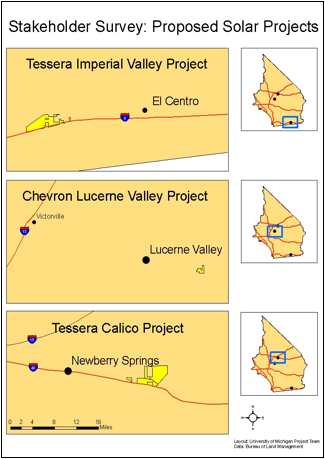The PDF of this chapter from the full report is available here:
Community Attitudes
Prior to this study, little research had been done to assess local communities’ attitudes regarding utility-scale solar energy development. Yet, the interests, opinions, and concerns of desert residents are both important and highly relevant because these individuals and communities will be directly affected by the development of multiple, utility-scale solar facilities in the California desert. They will experience many of the positive and negative impacts of development, and their support or opposition could influence the approval or denial of these projects.1 Because these communities have the potential to exert exceptional influence, it is important to consider the degree to which communities support or oppose solar development, reasons behind those opinions, the level of understanding of the technology and its impact, and the level of participation in the decision-making process. Answering these questions allows decision makers to both consider barriers and drivers to achieving objectives and to plan around them.

The importance of public opinion and public involvement in natural resource management is well recognized. A reflection of the need to involve “stakeholders” in land management decisions can be seen in the National Environmental Policy Act (NEPA) guidelines, which require that federal agencies hold public scoping meetings and public comment periods for major federal actions. Decisions made without adequate participation of affected groups often results in disputes, stymied decision-making, and costly administrative and judicial reviews.2
Using a case study like Nevada Solar One to analyze past impacts in tandem with additional research to predict future impacts offers valuable insight into how utility-scale solar development might, from a socioeconomic perspective, positively or negatively affect nearby communities. These methods, however, do not take into account the thoughts and concerns of residents of communities prior to construction. Moreover, our research extends beyond socioeconomic impacts, and we believe that public opinion of such developments is based on much more than jobs and housing. As described in our methods section, we therefore set out to complement our socioeconomic research with a stakeholder survey of those communities modeled, Lucerne Valley and El Centro, as well as Newberry Springs (Map 1). Our survey was intended to provide insight into stakeholder opinions and actions, information that might be used by both government agencies and private developers to consider how to best engage, inform and potentially influence stakeholders.
1 Weisskopf, M. “Tossing Out Trash-for-Cash Plans Like So Much Garbage.” The Washington Post National Weekly Edition. March 9-15, 1992.
2 Wondolleck, J. 1985. The Importance of Process in Resolving Environmental Disputes. Environmental Impact Assessment Review 5: 341-356.
